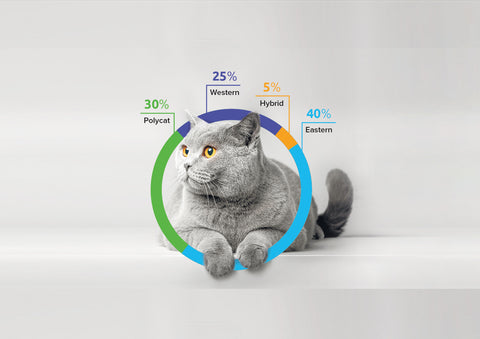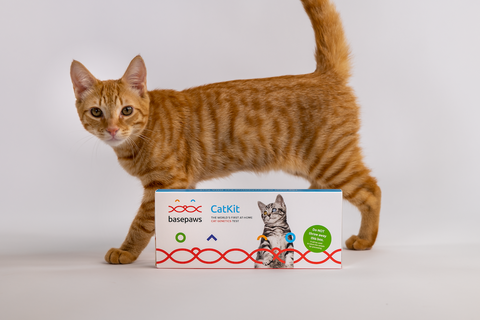
In 2018, Basepaws launched the world’s first at-home cat DNA test kit to help pet parents learn about the genetics behind what makes their cat unique, both inside and out. Integrity is a core value at Basepaws, and it guides our commitment to being a trusted leader in the field of feline genetics and pet health research. This extends to the periodic updates that we make to the Basepaws digital report of your cat’s DNA test results. These updates are informed by the latest scientific research to ensure that you receive information of the highest quality and that we continue to provide the most advanced health screening products available to support your cat’s overall well-being.
The Wildcat Index:
If you’d like to learn more about the concepts brought up here, read the blog “What is Genetic Ancestry, and What is it Not?” It explains more about genealogical ancestry and genetic ancestry as it relates to humans, and is applicable to our discussion here about cats.
The Chromosome Map and Statistical Confidence Slider:
- We removed the chromosome map and statistical confidence slider because we received consistent feedback that it was confusing. We originally created these visual interactive features as a supplemental way to communicate results.
- However, the static graphics and tables (see image below) with the summary of the percentage breakdown of the genomic similarity that your cat shares with each of the 21 purebred breeds within each of the four main breed groups were deemed the best method for clearly communicating your cat’s genomic similarity to breeds and breed groups.

Exciting New Features in the Basepaws Report
Now that we’ve summarized the features that are no longer a part of the report, let’s dive into the details about the new information you’ll receive that reflects the latest in feline genetics research! The Basepaws upgraded digital report now provides results for over 115 known feline genetic health markers—65 markers for genetic health conditions and 50 markers for traits.
1. Feline Blood Type and Blood Transfusion Risk.
- In a new section of the upgraded Basepaws digital report, you’ll learn about the genetic markers that may play a role in determining your cat’s likely blood type.
- The new report section also includes an assessment of your cat’s blood transfusion risk based on their likely blood type (A, B, or AB) result.
- Though we are thrilled to offer this new feline blood type and transfusion risk section in the Basepaws report, we still strongly recommend that you always have your veterinarian perform a serological blood typing test for your cat when blood type information is needed to make medical decisions.
- This is because a deeper understanding of the role of genetics in feline blood type determination is still evolving, so the feline blood type results in a Basepaws report should be interpreted as highly likely rather than 100% definitive.
2. 25 New Genetic Traits.
3. Genetic Markers for Feline Hypertrophic Cardiomyopathy
- Hypertrophic cardiomyopathy (HCM) is the most common feline heart condition. It causes an abnormal thickening of the heart's muscular walls and compromises overall heart function, which can lead to a range of issues in other systems of the body.
- The Basepaws Cat DNA test now screens for two additional genetic health markers associated with HCM to let you know if your cat is at a higher risk for the disease.
- This knowledge, along with risk results for any of the other genetic conditions for which Basepaws screens, can be incorporated into a proactive care plan that supports the overall health and well-being of your beloved feline companion.
4. Five-Star Scientific Evidence Grading System.
- We are proud to offer a new five-star scientific evidence grading system for every genetic health and trait marker result. The grading system for our genetic markers represents a deep dive into the available feline genetics research, including the very latest findings.
- The Basepaws scientific evidence grading system answers the following important question: How strong is the existing evidence that this marker is associated with this disease or trait?
If you have additional questions about your cat’s Basepaws digital report, please email us at meow@basepaws.com. We are grateful to you and to all of the members of the Basepaws community who are prioritizing proactive health decisions for your cat’s happiness and overall well-being.
If you’d like to make an impact in the lives of cats now and in the future, don’t miss out on an opportunity to join the Basepaws citizen science research program, which directly contributes to our work to refine our current products and develop new ones for early recognition, intervention, and treatment of diseases that affect the health of pets everywhere.
Explore more Basepaws tests!


